Regional economy. Рубрика в журнале - Economic and Social Changes: Facts, Trends, Forecast
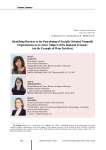
Статья научная
Due to the difficult socio-economic situation of Russia’s regions, it is necessary to involve nongovernmental providers of socially significant services to eliminate government failures. In this regard, socially oriented nonprofit organizations play an important role. As practice shows, despite the recognized importance of such organizations, their potential in the regional economy is not implemented to the fullest extent. Reasons for such a situation are studied in a large number of works, but they do not always take into account territorial specifics, which makes it difficult to identify specific areas of problem solving. Thus, the aim of this study is to identify barriers to and prerequisites for the sustainable development of socially oriented nonprofit organizations as an active subject of the regional economy, effectively implementing its functions in socially significant sectors of the economy on a systematic and long-term basis. To achieve this goal, we analyze the functioning of socially oriented nonprofit organizations (using the example of Perm Territory). The information base includes a set of relevant regulatory documents, data from state and departmental statistics, ratings of RF constituent entities, findings of sociological research commissioned by the Grants Fund of the Governor of Perm Territory in 2020-2022. We systematize the problems that socially oriented nonprofit organizations deal with in their work, according to the impact on the organization, respectively, related to the external and internal environment. On this basis, we outline the conditions necessary to increase the sustainability of the development of socially oriented nonprofit organizations in the region.
Бесплатно
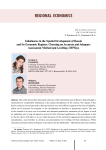
Статья научная
One of the factors determining the structure of the expenditure part of Russia’s federal budget is represented by considerable imbalances in the spatial development of the country. The impact of this factor consists in the annual need to allocate funds to non-self-sufficient regions in the form of subsidies, which can be directed, for example, to the development of business in prosperous entities. The aim of the research is to carry out an accurate and adequate quantitative assessment of the degree of such an imbalance over a long retrospective period of time. Practical significance of the assessment is due to the fact that it will allow us to see which decisions of the authorities aggravated the problem under consideration, and therefore to develop recommendations for levelling off these imbalances. When choosing a method to achieve the goal, we decided to use the Herfindahl - Hirschman index that contains a modification proposed by Professor S.G. Svetunkov, which eliminates its disadvantage consisting in the dependence of the final value on the number of units included in the set under consideration. The use of this indicator has become the main element of the scientific novelty of the study. Having assessed the degree of heterogeneity of the Russian economic space on the basis of information retrieved from the official website of the Federal State Statistics Service, we use regression analysis to derive an equation describing its impact on the structure of the expenditure part of the federal budget. According to the viewpoint that we share, the key tool consists in smoothing out the imbalances within the economic regions that form the country. Their assessment is carried out in a similar way and is also an element of the scientific novelty of the study. Guided by the results obtained, we identify regions where the elimination of vulnerabilities can reduce the heterogeneity of the economic space of the respective economic regions and Russia as a whole. The indicator tested in the study can be used in the future, for example, to assess the degree of uneven distribution of various resources (material, financial, etc.) on the territory of Russia.
Бесплатно
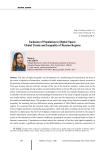
Inclusion of population in digital space: global trends and inequality of Russian regions
Статья научная
The issue of digital inequality and development of a methodology for measuring it has been at the center of attention of researchers, members of public administration, companies directly involved in the provision of Internet communication services, and other interested parties for more than twenty years. This issue became relevant with the increase of the rate of the Internet spread in certain parts of the world, and, accordingly, the lag of other countries behind them in the late 90s and early 21st century. The sphere of information and communication technologies is one of the most rapidly changing ones, which is probably why the theoretical and methodological foundations of the study of digital inequality are still not clearly defined, which actualizes research in this area and the importance of monitoring trends in the world and individual states. The purpose of our work is the usage of the three-level model of digital inequality for assessing first-level differences among population of Third World countries and Russian regions. It is assumed that the research results will create prerequisites for continuing study on other levels of digital asymmetry among Russian population, which will allow revealing not just the fact of its inclusion in digital space but the level of digital competencies and opportunities provide by the usage of modern information technologies. We use a set of scientific methods; for measuring inequality, the author resorts to the calculation of the variation coefficient, grouping of countries or regions based on levels of Internet connectivity. Conclusions are drawn about the existence of the first-level digital inequality in the world, despite a significant decrease of the differentiation of countries by Internet connectivity. It is revealed that Russia, in comparison with other countries, shows a significant increase of the share of Internet users, and there are elements of digital divide within Russian regions even with the decrease of variation coefficients. The scientific novelty of the study is the assessment of the scale and dynamics of the first-level digital inequality among population at the country and regional levels, grouping of countries, and Russian regions by the share of Internet users and the usage of mobile devices to access the network.
Бесплатно
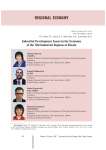
Industrial development issues in the economy of the old industrial regions of Russia
Статья научная
Achieving balanced economic development is a key task for old industrial regions, in which many industrial sectors are concentrated. However, current macroeconomic situation does not promote the development of industrial sectors and new technological modes; moreover, it can lead to a decline in production output, tax proceeds, people's real incomes, consumer demand and other negative trends in socio-economic development. A considerable gap in labor productivity between Russia and developed countries as well as between old industrial regions indicates the existence of major problems in Russian industry. For this reason, the aim of the research is to identify main trends and issues in the industrial sector of old industrial areas in order to work out its further development prospects. Methodological framework of the study includes economic, statistical, and comparative analysis, generalization, and sociological survey. The works of Russian and foreign economists in the field of regional economics, official data of the Federal State Statistics Service, databases of international organizations including the World Bank, the Organization for Economic Cooperation and Development and the U.S...
Бесплатно
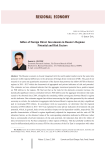
Inflow of foreign direct investments in Russia's regions: potential and risk factors
Статья научная
The Russian economy is closely integrated with the world capital market and at the same time possesses visible regional differences in the dynamics of foreign direct investment (FDI). The goal of our research is to carry out quantitative assessment of the factors that promote the inflow of FDI to Russia's regions in 2011-2017 within the framework of aggregated and private indicators of risk and potential. The estimates we have obtained indicate that the aggregate investment potential has a positive impact on FDI inflows to the regions. We find out that as the risks for the domestic economy increase, the statistically significant inverse correlation between FDI inflows and the aggregate investment risk index ceased to be observed since 2014, alongside the remaining visible convergence between Russia's regions on this indicator. Our estimates suggest that without overcoming the high risks generated by the national economy as a whole, the reduction in aggregate risks between Russia's regions does not play a significant part in increasing FDI inflows. In accordance with our assessment, we determine that the regional dynamics of FDI inflows in 2011-2017 was explained by some private indicators of investment risk and potential, which, in general, had a reverse and direct impact on the dependent variable, respectively. The specific characteristics of Russia's regions significantly adjusted the importance and the ratio of FDI attraction factors, so the obtained values of the corresponding elasticities indicated a difference rather than a commonality of private indicators of risk and potential, the indicators that drive the inflow of direct investment to the Far East compared to other regions of Russia. This fact probably confirms the need for differentiated policies to attract FDI to the economy of the Far East in comparison with other regions. Since our research reflects the relative impact of risk and potential factors on FDI inflows for Russia's regions that exist in the single institutional and economic space, the estimates we have obtained can be supplemented by a more detailed study of the role of Russia's potential and risk compared to other national economies.
Бесплатно
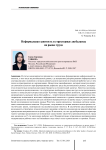
Informal employment and structural imbalances in the labor market
Статья научная
The paper analyzes principles and mechanisms related to the development of informal employment, including at the regional level, where the accelerated growth of the informal sector is mainly caused by low living standards and lack of jobs, including in enterprises and organizations. The lack of skills, which is often a key aspect in the formation of labor shortages in regional markets, is mediated by relatively low budget expenditures on human capital. The hypothesis of the study is that structural imbalances in the demand for labor and its supply, one of the indicators of which is the extent of informal employment, determine the tension in the labor market. The aim of the work is to theoretically substantiate and empirically confirm the relationship between the extent of informal employment and the level of economic development, and to identify opportunities to reduce tension in the labor market. Statistical basis of the study includes Rosstat data; research tasks were solved using economic and mathematical analysis methods. The results obtained by analyzing statistical series confirmed the research hypothesis. In conclusion, we consider the possibility of structural and technological maneuver in economic sectors as an important factor in overcoming tension in the labor market. In particular, due to the labor-saving nature of such a maneuver, it is possible to significantly increase labor productivity by at least 15 million jobs. Construction and trade may become priority industry areas for workplace modernization in the coming years. The results of our calculations are considered as a preliminary assessment of the possibilities of labor productivity growth at the macro level, involving the development of special sectoral and regional programs to increase labor productivity, which is the practical significance of the results obtained.
Бесплатно
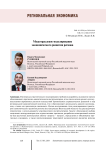
Input-output modeling of economic development in the region
Статья научная
In the interests of strategic planning it is necessary to design and develop scientifically substantiated forecasting and analytical tools, including those used to carry out variant calculations of the consequences of management decisions and regional economic policy measures; this determines the relevance of our study, as well as its applied significance. The aim of the research is to model the trajectories of the region's economic development (in the case of the Vologda Region) for the medium term with the help of input-output tables. Tasks: to substantiate the choice of model tools for making forecasts, to develop an input-output model based on calculated regional input-output tables, to identify and substantiate forecast scenarios, as well as to forecast the trajectories of the region's economic development in the medium term as a demonstration of the capabilities of the model toolkit. The article presents the results of scenario forecasting in relation to the trajectories of the economy of the Vologda Region as a model region for the medium term under the influence of various structural policy instruments. We use our own recursive input- output model of the regional economy as a key forecasting tool, which makes up its scientific novelty. Within the framework of three forecast scenarios (inertial, adaptive and transformational), we determine the average annual rate of change in the main indicators of regional development (gross regional product, gross output, investments in fixed assets and net exports) in the medium term, as well as the industry (sectoral) parameters of the Vologda Region's economic structure as of the end of the forecast period. The results obtained in the course of the study are in line with macroeconomic forecasts for development of the national and regional economies in the short and medium term.
Бесплатно
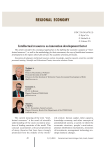
Intellectual resources as innovation development factor
Статья научная
The article considers the conceptual approaches to the defining the economic category of “intellectual resources”, as well as the methodology for their assessment, the ways of intellectual resources development in the regions which did not have the academic divisions previously.
Бесплатно
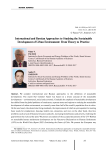
Статья научная
We consider international and Russian approaches to the definition of sustainable development. The report Our Common Future was based on a triune concept of the sustainable development - environmental, social and economic. Gradually the emphasis of sustainable development has shifted from the global problems of continents, separate states and regions to studying the sustainable development of urban environment, as currently more than half of the world’s population lives in cities. On the one hand, cities determine living standards, the improvement of which is a prerequisite for meeting basic needs for employment, housing, health care, education, and rest; on the other hand, they face problems such as lack of financial resources and jobs, increasing homelessness and poverty, widening the gap between the rich and the poor. We present an analysis of the accepted documents of the UN-Habitat on sustainable human settlements development on the Vancouver Declaration on Human Settlements (1976) to the World Cities Report 2022: Envisioning the Future of Cities. We present the European way through the European Charter. The main points and concepts of the sustainable development of big and small cities of Europe are considered from the Aalborg Charter (Denmark, 1994) to the Mannheim Message (Germany, 2020). We analyze northern city ranking, which has been implemented by the Rating agency SGM since 2013. We propose a methodology for assessing the sustainable development of northern cities on eight demographic and labor indicators; conduct a grouping of 115 cities of the Russian North on the types and indicators of the sustainable development, and mark 10 most sustainable cities and 10 - with the worst ranking. The considered theoretical provisions and practical results can be used for comparative studies and planning of territorial development. We suggest the directions for improving the sustainable development of Russia’s northern cities.
Бесплатно
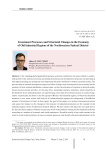
Статья научная
In the changing global geopolitical and geo-economic conditions, the issues related to sustainable growth of the national economy, promoting its pronounced development dynamics and providing it with high technology are among the most important directions for Russia's modern economic policy. The priority tasks of national development require an inflow of large-scale investments in the economy, but the question of their rational distribution remains open, so that the attention of investors is directed mainly toward resource-based activities. At the same time, knowledge-intensive industries, which should be at the forefront of new industrialization, are experiencing a clear lack of investment and are in a state of stagnation. In particular, the above is true for a group of Russia's old industrial regions, in which the described situation is even more serious and leads to de-industrialization against the background of insufficient amount of investment at hand. In this regard, the goal of the paper is to analyze investment processes and assess their impact on the changes in the structure of industrial production on the example of old industrial regions of the Northwestern Federal District. We have chosen this object for our study due to the fact that these subjects of Russia occupy one of the worst positions among all old industrial territories according to a number of economic and social parameters. Scientific novelty of our work consists in the need to reveal modern patterns of socio-economic processes and identify structural deformations in the economy. The findings of our study reflect the current state of investment processes and the nature of structural transformations in the old industrial regions of the Northwestern Federal District, taking place against the background of strengthening resource-based industries. Practical significance of the findings is determined by the fact that they contribute to a better understanding of the current socio-economic situation of the sample under consideration and are useful for further study of the specifics of these territories and the problems they face.
Бесплатно
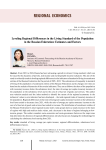
Статья научная
From 2021 to 2024, Russia has been witnessing a growth in citizens’ living standard, which can be traced by the dynamics of poverty, real income and real disposable income indicators. The aim of the study is to identify trends in leveling regional differences in the indicators of standard of living in constituent entities of the Russian Federation for the period of 2005–2023. The estimations of inequality in standard of living of the population of constituent entities of the Russian Federation and its changes over time are based on the analysis of dynamics of the certain indicators. They are as follows: the share of the population with monetary incomes below the subsistence level, the ratio of average per capita monetary incomes of the population to the subsistence level and to the cost of a fixed set of goods and services. The author uses variation analysis and the index method to identify the nature of the regional asymmetry in the indicators’ values; a new indicator has been developed – the total regional index of monetary incomes of the population. Regional differences in the ratio of average per capita monetary incomes to the subsistence level have tended to decrease since 2021, while the ratio of average per capita monetary incomes to the cost of a fixed set of goods and services has tended to increase. The distribution of constituent entities of the Russian Federation by total regional income index value groups shows a steady increase in the share of regions with high and medium index values, and a decrease in the share of regions belonging to low-income groups. The author considers socio-economic and socio-governance factors as the major ones that determine the direction of regional differentiation; she also focuses on changing the methodology for calculating the subsistence level starting from 2021.
Бесплатно

Long-term dynamics of the impact of gravitational factors on foreign trade of the Russian Far East
Статья научная
The aim of the research is to assess the dynamics of the impact of gravitational factors on foreign trade of the Russian Far East; the factors include physical distance, size of economies participating in trade, and the presence of a land border. The data array generated for the Far East in the “new” territorial boundaries for 2000-2021 indicated the focus of foreign trade of the Russian macroregion on the neighboring and large economies of Northeast Asia with a gradual dominance of China, as well as a decrease in the share of the southern Far East regions in trade turnover with border countries. Based on the technique of solving the “distance puzzle”, estimates of gravity dependence indicate an increase in the positive impact of the size of economies on the foreign trade of the Far East by 9.1% by 2021 compared with 2000 and a decrease in the negative impact of physical distance by 4.3%, respectively. According to the estimates obtained, we reveal the long-term dynamics of the Far East economy “gravitating” toward the foreign rather than domestic market. The positive impact of the presence of a land border on the foreign trade of the Far East regions was determined only in the 2000s. It contributed to an increase in their trade turnover by 209% in 2000 and by 86% in 2009. The leveling of the positive impact of the land border on the foreign trade of the Far East border regions in 2010-2021 was revealed due to the following reasons: mass exports to China from regions that do not have a land border with China; orientation of border regions toward the market of the rest of the Russian regions; decrease in the intermediary role of border regions between China and other Russian regions; small scale, volatility and specificity of trade with Mongolia and the DPRK; negative impact of quarantine measures related to the pandemic. It is assumed that in the context of current restrictions in relation to Russia, an important aspect of the development of the Far East economy should include diversification of trade interactions between the regions of the Far East and China, including through promoting cross-border cooperation.
Бесплатно
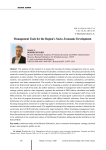
Management tools for the region's socio-economic development
Статья научная
The purpose of the research is to assess the focusing of existing management tools on socio-economic development (SED) of the Russian Federation constituent entity. The practical rationale of the research is caused by general problems of regional development and the need to develop methodological approaches to their solution. The author used qualitative methods of cross-sectoral analysis, document analysis, and quantitative methods (those of principal components, variance calculation, correlations, regressions, and index construction). The novelty of the research is related to comparing management tools at the federal and regional levels, as well as to designing a number of administrative staff based on these tools. As a result of the study, the author proposes a method of management tools evaluation (SED strategy, priority projects, state programs), approves the methods of SED indices calculation and public services development, as well as the methods of rationing the number of managerial staff in line with SED priorities. The main conclusion is that the assessment of stated goals’ achievement is complicated by a low level of program documents’ compliance with official statistics indicators. Since the sectoral distribution of a number of state apparatus employees is not optimal, the author proposes its adjustment, focusing management personnel on achieving region’s development priorities. The results obtained are correlated with the labor market trends. The applied forecasting of the employees number is limited by the correctness level of SED and labor productivity target indicators. When developing management tools, the regions are recommended to take into account statistical indicators that are relatively objective and to focus the performers on achieving final socially significant results. The proposed method has the potential to be replicated in the constituent entities of the Russian Federation addressing similar problems in the field of SED.
Бесплатно
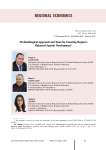
Methodological approach and tools for ensuring region's balanced spatial development
Статья научная
Due to the concentration of labor, financial, and other resources in agglomerations and “denudation” of regions' periphery, a number of significant problems are becoming more acute in the transformation process of spatial economic structure. Such problems threaten the balance of intra- and interregional development. One of them is an important differentiation of Russian regions' municipalities in terms of socio-economic development level. There is a dilemma of choosing the regional spatial policy vector: either to support the growth points' development (agglomerations, special economic zones, territories of advanced socio-economic development), or to reduce socio-economic inequality through additional support for the periphery development. Using the integration of the concepts of the reference frame and sub-regional approach, the research proposes a methodological approach to the balanced spatial development of the region. On the region's territory, the research distinguishes natural sub-regions, which are the elements of the territory's reference economic frame, and artificial sub-regions, which are based on inter-municipal cooperation. The essence of the approach is to establish balance between regulation of natural economic processes in the region (for example, institutionalization and reduction of agglomerations' negative effects) and state support for depressed territories' development (for example, program sub-regions' formation). Its usage in the regional management practice allows forming methodological basis for working out strategic documents for the region's spatial development, economic, organizational, institutional, and social instruments of regional policy. The work presents a set of tools for improving the spatial development balance of the Republic of Bashkortostan, related to the development of natural sub-regions which are already objective growth points in the region, as well as aimed at stimulating the economic self-development of depressed and peripheral territories of the Republic of Bashkortostan.
Бесплатно
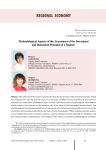
Methodological aspects of the assessment of the investment and innovation potential of a region
Статья научная
The relevance of the study is caused by the fact that the increase of the investment activity, which has remained low over the last few years, is a necessary condition for the transition of the country's economy to an innovative development path. It leads to the preservation of technological backwardness which conserves the structure of the economy with a low share of the knowledge-intensive sector. The interdependence and interconnectedness of investment and innovation processes allows us to review the investment and innovation potential as the basis of their development. While studying scientific papers, it was revealed that issues of content, structure, and the evaluation of this potential are debatable, and they require further comprehension. The purpose of this article is to develop methodological provisions for assessing the investment and innovation potential of the region. In the course of studying the works of domestic and foreign scientists, the authors of the article investigated approaches to determining innovation and investment potentials and methods of their assessment, clarified the content of investment and innovation potential, identified its structural elements, and proposed a methodological approach to its assessment, which allows establishing the relationship between used investment resources and the results of the innovation activity. During the study, we assessed the investment and innovation potential of Russian regions, identified problems of its formation and the usage, as well as trends that make it possible to determine the guidelines for the development of investment and innovation processes. The methodological basis of the research are the methods of system analysis and synthesis, comparison, generalization, grouping and statistical methods. The results of the study may be of practical interest for regional authorities' activities and the management in order to improve the effectiveness of investment and innovation processes. Theoretical generalizations, contained in the article, might be used as materials for the discussion in a scientific discourse.
Бесплатно
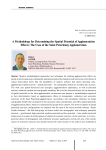
Статья научная
Modern methodological approaches and techniques for studying agglomeration effects are aimed at determining and evaluating the spatial potentials of development and interaction of territories of various hierarchical levels. But the possibilities of modern software that allows detecting intraagglomeration spatial reserves - spatial potentials - on cartographic models are not taken into account. The work uses spatial-functional and synergetic (agglomeration) approaches, as well as potential method, statistical method and cartographic modeling. We reveal the theoretical basis for the formation of spatial potentials in the intra-agglomeration environment and propose a methodological approach to their determination based on agglomeration effects of demographic, settlement and economic structures of the Saint Petersburg agglomeration. According to the calculations obtained, we design cartographic models that correspond to the structures under consideration and reflect spatial potentials of agglomeration effects, which are represented by groups of five clusters. The levels of clusters of spatial potentials and their configurations are obtained with the help of the neural network software “Surfer Golden Software”. We find that groups of clusters within the demographic and settlement potentials structure - gravitational, high-potential, medium-potential and low-potential - have smaller territorial impact areas in contrast to similar groups of clusters of economic structure. At the same time, a very low-potential cluster of demographic and settlement structure significantly exceeds the area of the similar cluster of economic structure and spreads beyond the cities located in the eastern and southeastern parts of the Saint Petersburg agglomeration periphery. The areas for future research are related to the development of new methodological approaches and techniques aimed at searching for and modeling agglomeration effects and their spatial potentials in the functional structures of individual cities, urban agglomerations or regions (investment, innovation, environmental, transport, service, cultural and other structures). Another promising area consists in determining spatial potentials based on the agglomeration effects of individual large enterprises with the help of quantitative indicators reflecting their performance effectiveness; this direction is difficult to implement due to the lack of open statistical data.
Бесплатно
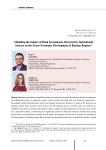
Статья научная
Banking capital plays a significant role in providing the financial foundations for the development of institutional sectors in regional systems, which include financial and non-financial corporations, households, public administration sector and foreign institutions. However, a study of the processes of banking capital flows between them shows that the banking sector currently does not perform its traditional functions of saving institutional sectors’ capital and providing them with loans, but carries out a speculative policy, contributing to a significant outflow of financial resources abroad and causing serious harm to the Russian economy. In this regard, the purpose of the work is to study the imbalances in the processes of banking capital flows between institutional sectors and to model the impact of bank investments attracted by institutional sectors on the socio-economic development of constituent entities of the Russian Federation. We have developed a methodological approach based on the methodology of forming balanced matrices of financial flows between institutional sectors using data from the primary accounting statements of loan institutions, the methodological principle of double entry bookkeeping of the System of National Accounts and methods of regression analysis using panel data. We built matrices of financial flows in the regions, characterizing the processes of bank capital flows between the sector of financial and non-financial corporations, public administration, households and foreign institutions, regression models characterizing the impact of bank investments attracted by each institutional sector on the indicators of socio-economic development of regional systems. The study has found that the capital raised by banks in the sector of non-financial corporations has a positive impact on the dynamics of the gross regional product of Russia’s constituent entities, leads to a decrease in unemployment in the regions, the number of people with incomes below the subsistence level, the degree of capital consumption, as well as an increase in the balanced financial performance of enterprises and the average monthly nominal wage.
Бесплатно
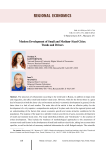
Modern development of small and medium-sized cities: trends and drivers
Статья научная
The processes of urbanization occurring in the world and in Russia, in addition to large cities and megacities, also affect small and medium-sized cities. However, while for the former there is a great deal of research on both the inner-city environment and socio-economic development in general, for the latter there is a lack of such studies. The main idea of the article is that an effective policy for the development of a city requires a comprehensive analysis of its place and role in the regional system and an understanding of the factors that ensure economic growth and create attractive conditions for the population. The purpose of the paper is to identify trends in and drivers of socio-economic development of small and medium-sized cities. The study identified problems and “bottlenecks” in the analysis of urban development. They include the weakness of methodological approaches to the assessment of current trends and factors in the development of small and medium-sized cities, taking into account their specifics, as well as the lack of necessary statistical information for a full-fledged analysis. The scientific novelty of the study lies in the fact that we propose our own methodology for determining the trends and factors in development of small and medium-sized cities, which differs from traditional approaches by including the analysis of the distribution of cities in the regional system (according to Zipf’s law) in the dynamics and constructing a system of econometric models of the influence of factors on social and economic development. Testing the proposed approach in the Belgorod Oblast revealed a trend of divergence of small and medium-sized cities, increasing imbalances in population distribution, and the growth of small urban and rural settlements near Belgorod. The scientific hypothesis of the study is that the socio-economic situation in small and medium-sized cities is primarily positively influenced by investment in fixed capital and only then by such factors as an increase in housing stock, educational development, the work of sports and cultural institutions. The factors contributing to the social and economic development of cities are investments in fixed capital, the total number of residents, especially schoolchildren, the housing supply, and the development of sports and cultural institutions. The research findings are of practical value for the design and implementation of development policies for small and medium-sized cities in Russia.
Бесплатно
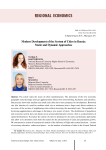
Modern development of the system of cities in Russia: static and dynamic approaches
Статья научная
The article raises the issues of urban transformation. The provisions of the new economic geography state that large cities get agglomeration effects from overcrowding, businesses and amenities. But practice shows that medium and small cities often have more prospects for development. Borrowed size (the location of a small or medium-sized city or settlement near a larger one) allows residents to use some of the services of neighboring cities without incurring the associated costs. The possibility of borrowing agglomeration advantages is forming a new system of cities. The distribution of population and economic activity does not always occur around administrative centers, there is a polycentricity of spatial development. To analyze the system of cities we proposed to use static and dynamic approaches that allow us to determine more fully the reasons for the attractiveness of cities and population growth. We constructed a system of econometric models of the influence of high order urban functions - factors of economy, education, culture and sports - on the number of residents of cities in the Central Federal District of Russia as a whole and by size categories. The analysis of polycentricity of cities revealed that a high level of the indicator is observed in the Moscow, Vladimir, Belgorod, Tula, Tver and Kaluga oblasts, and low polycentricity is in the Lipetsk, Ryazan, Voronezh and Orel oblasts. It was determined that the attractiveness of cities and the growth of their population are influenced by high-order urban functions (business, science, sports and culture), the ability to take advantage of “borrowed” size, the external effects of the urban network and the level of inter-city cooperation. The most significant factor in the growth of the city is the number of schools. The second factor is the possibility for children and adolescents to join sports clubs. Budget expenditures have a positive impact on the growth of large, big and small cities. Cultural and recreational activities are significant for the attractiveness of cities with a population of up to 10 thousand people and from 15 to 20 thousand people. It was revealed that more than a half of settlements in the Central Federal District are cities and urban-type settlements with population less than 10 thousand people. For this group, all the considered development factors are statistically significant and important. The results can be used to further develop the ideas of static and dynamic analysis to assess the reasons for the attractiveness of cities, substantiate the “borrowed size factor”, and determine general trends in the system of cities formation. The practical value of the work lies in a better understanding of the principles for creating an attractive city for residents at different stages and conditions of its development; it can be used in the development of appropriate socio-economic programs at the city and regional levels.
Бесплатно
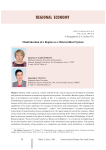
Modernization of a region as a heterarchical system
Статья научная
Modern world is dynamic, variable and full of risks, which requires the development of flexible and dynamic mechanisms to modernize regional social systems. For modern Russian regions, different in pace of development and people's quality of life, it is important to develop such theoretical and methodological approaches to based to identify resources and problem areas of modernization. The research novelty lies in the analysis of modernization in a region using the theoretical and methodological capabilities of the system approach, the concepts of heterarchy and modernization. We emphasize the overlap of subject fields of terms “heterarchy”, “region”, and “modernization” in matters of principles (value basis) of modernization process management in the region using the heterarchy resources. Based on the results of the monitoring sociological study conducted during 2010-2016 in the Astrakhan Oblast sing the interview method at the place of residence according to the Standard Methodology of the all-Russian program “Socio-Cultural Evolution of Russia and its Regions”, we revealed the strengthening of the vertical of power, that is, hierarchical relations in the institutional and regulatory sphere...
Бесплатно

